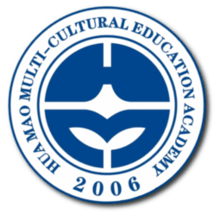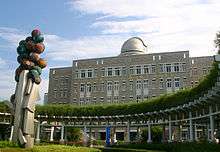Huamao International School
| Huamao International School | |
|---|---|
 | |
| Location | |
|
Zhejiang Ningbo China | |
| Information | |
| Type | Independent, International, Day and Boarding |
| Established | 2006 |
| Principal | Cheryl Keegan |
| Employees | ~110 [1] |
| Enrolment | ~650 (K–12)[1] |
| Colour(s) |
Maroon, Navy, Light-Sky Blue and Gold |
| Slogan | "Welcome to the world" |
| Website | www.mea-international.com |
Ningbo Huamao International School (NBHIS, Chinese: 华茂国际学校), previously known as Multicultural Education Academy (MEA), is a school for international, expatriate students and Chinese nationals in Yinzhou district, Ningbo, Zhejiang, China. The school opened its doors in 2006 on the grounds of Huamao Foreign Language School. It is in the fast developing Yinzhou District next to Wanda Plaza and close to the University of Nottingham Ningbo Campus. Hua Mao Foreign Language School is a primary, middle and senior school of 5,000 students. NBHIS has 820 students and more than 110 teaching staff from over 35 countries. The school is co-educational and open to both boarding and day students. The 650 students are split into three groups: 570 doing the IB programmes leading to tertiary options around the world, 100 foreign students doing the HSK for entry into Chinese universities, and 150 Chinese students in Sino-Canadian and Sino-American programs. In October 2015 the school became a member of the Round Square Conference of Schools following Board approval at the global conference held at United World College of South East Asia (UWSEA).

History
Huamao Group purchased an ‘international school’ from Denise Bradford in 2006. The school was originally called the Australian International School Ningbo, then Huamao Multicultural Education Academy (MEA) and now, due to a government license change, allowing NBHIS to accept Chinese nationals alongside foreign nationals, it is Ningbo Huamao International School. It initially held as many as 40 students but dwindled to eight paying students in early 2008. During that year Hua Mao searched for a ‘western partner’ to help manage MEA. In 2008 the school signed a joint venture agreement with Mowbray International to jointly manage it. In early 2008, Paul Stephens arrived as interim principal with his wife and two children. Stephens stayed at Hua Mao until the agreement was signed in September 2008. Ivan Moore arrived in December 2008 and was considered the founding principal.
The school has undergone 6 sets of renovations and facility developments, vastly changing the facilities. The school has built two new reception area, dance drama studio, music suite and Music auditorium, staff room, a library and a reading room, home economics room, soft play areas, and indoor and outdoor play areas, and, in 2015, a new kitchen and dining room for primary students and an adventure playground. Classrooms are well equipped with access to internet, data projectors and computers.
The school is in Hua Mao Foreign Languages School, a school of more than 5,000 students. The Hua Mao campus has two stadiums, indoor swimming pool, three large auditorium that seat between 300 and 500, a $10 million art gallery designed by Wang Shu, and a five-storey science museum with a cinema that can seat 260.
The three objectives in the school's early development were: “make it safe, make it fun, and make it academically rigorous”. The vision of the school notes the importance of mixing Eastern and Western curriculum, ideas and trends, to enable all students to learn from each other.
Principals
| Period | Details |
|---|---|
| January 2008 – September 2008 | Paul Stephens (interim) |
| September 2008 – December 2008 | Shirleyta Gerald (acting) |
| December 2008 – July 2015 | Ivan Moore (Founding) |
| August 2015 – current | Cheryl Keegan |
PYP coordinators
| Period | Details |
|---|---|
| February 2008 – July 2009 | Shirleyta Gerald |
| August 2009 – July 2010 | Melissa Biglands |
| August 2010 – July 2014 | Abhilasha Jain and Faye Jiang |
| August 2014 – March 2015 | Glenn James and Faye Jiang |
| March 2015 – current | Abhilasha Jain and Faye Jiang |
DP coordinators
| Period | Details |
|---|---|
| August 2011 – August 2016 | Maggie Ye |
| August 2016 – current | Shameek Ghosh |
Logo and school colours
The NBHIS logo has key elements that are common across the Huamao Group. The design was to represent the H and M for Hua Mao. The logo was also designed to stress:
- the shape of a young sapling referring to the young children and adults in Huamao's care and with reference to the strong roots (or foundation) that education would bring to the students at the school
- the H to be shaped as a set of lungs representing breathing new life into a reformist approach to education and for students to seize every opportunity available to them.
NBHIS has four school colours: maroon, navy blue, light blue and gold. The navy represents Ningbo as a seaside port and as such has links to the rest of the world. The light blue represents the sky, encouraging students to reach for lofty heights. Maroon represents the blood of the people and the long history tracing back to 4,800BC. A strip of gold was introduced to signify a wealth of knowledge.
Governance
NBHIS (as MEA) was governed as a joint venture by Huamao Education Group and Mowbray International until May 2012. Hua Mao Education Group took over full operational control of MEA in June of that year. The principal is appointed as CEO and is answerable to the chairman of Huamao Group, Xu Wanmao.
Boarding
Primary age students board at NBHIS facilities. They have lessons in the afternoons with Chinese teachers and in the evening by two boarding mistresses. Students in the Middle School and Senior School board within the International Department Boarding house with Huamao Foreign Language School. Senior students study within MEA in the evening.
The majority of the students are day students.
Curriculum
Bilingual education is a cornerstone of the education at NBHIS. Kindergarten classes are taught by three staff: a foreign teacher, a Chinese teacher, and an assistant. Classes maximise opportunities for students to learn English and Chinese. In the senior school classes are taught by expatriates and Chinese teachers. Much of the bilingual education model by follows the advice of Professor Ofelia Garcia, of the Ph.D. programs of Urban Education and of Hispanic and Luso-Brazilian Literatures and Languages at the Graduate Center of the City University of New York.[2] In NBHIS, students start in a bilingual pre-school environment, migrate to the primary school where English is the predominant language of instruction, but which includes strong stand alone Chinese instruction, and then onto the Middle School where students continue to develop English as their primary language of instruction, while protecting and extending their mother tongue. Diploma Program students study English.
In 2011 MEA introduced an iPad program as part of its efforts to help students enter a 21st-century economy and learn 21st-century skills. In addition, students create websites, IT is explicitly taught within an inquiry-based education. An English Language Centre was opened in 2013 and a Special Educational Needs (SEN) program in 2014.
NBHIS is an International Baccalaureate Primary Years Program (PYP) and Diploma Program (DP) World School. Authorisation for both programs was awarded in May 2012.[3]
In June 2014 the first cohort of IB DP graduates completed their studies. They achieved an average IB DP score of 33 and 50% entered the world's top 50 universities. In May 2015 it was reported that the 16 graduating students in the IB DP had been offered nearly $1 million in scholarships from universities in the USA, Canada and UK.
Extra-curricular activities
Extra-curricular activities are broken into two types: Electives that occur within the timetabled day and co-curricular activities that occur after school. The program teaches additional languages such as French, Korean and Spanish; sports such as soccer, baseball and field hockey; Chinese culture such as calligraphy, Pinyin classes; and musical instruments such as piano.
Sister schools
MEA has sister school relationships with Columbia International College in Hamilton, Canada enabling students to do a 2+1 or 3+0 Canadian program for Chinese students. In addition, Sidcot School in Somerset, England and Tirana International School in Albania have formed close sister-school relationships for exchange, a living laboratory, and GAP programs.
References
External links
- Ningbo Huamao International School (simplified Chinese)
- www.nbhis.com